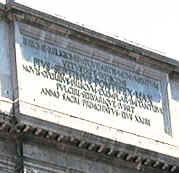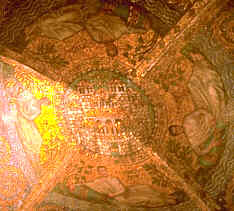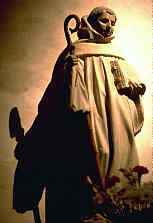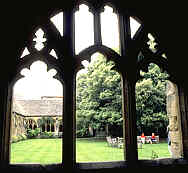






If you are looking at this page without frames, there is more information about medieval writing to be found by going to the home page (framed) or the site map (no frames).
| Authors | |||||||
| The direct genealogy of medieval written works leads us to ancient Rome. This is a terrible admission if you happen to be an archaeologist-cum-anthropologist who has spent years arguing with classicists about who invented culture. The pedigree is unbroken despite a few minor incidents along the way like the fall of the Roman Empire and the wave of pagan barbarians who took over western Europe during what we call the Dark Ages; an expression which reflects our ignorance rather any especial brutishness of the era. Unbroken does not mean unaltered however, and the authors encountered on the medieval journey have themselves altered our perception of our distant literate past. |  |
||||||
| Gratuitous picture of the forum in Rome, just to show a few picturesque ruins of literate civilisation. | |||||||
 |
Rome was a literate society. It produced authors who wrote books, poetry and plays. It conducted its legal and business affairs through the medium of written record. It stuck inscriptions on its excessively large monuments and on the tombstones of its dead. It also spawned the Christian religion, initially colonial, outcast and persecuted, but then nurtured to become the literate engine of developing medieval Europe. | ||||||
| Inscription on the Arch of Titus in Rome, commemorating the conquest of Jerusalem in AD 70. | |||||||
| Literate culture was reintroduced to much of western Europe through the enclaves of missionising monastic communities. Naturally their early books included Gospels, Bibles and works of liturgy, from anonymous authors. They included an increasing body of work by known authors, early Christian commentators who composed what is termed the patristic literature. They also preserved and transcribed the works of Classical authors, the content of some of which might seem to have little relevance to a monastic community. Perhaps these represented literate culture in a generic sense, under siege but nevertheless under the guardianship of the religious communities which transmitted them over centuries. |  |
||||||
| Pope Gregory the Great, a patristic author, is depicted in a portal figure on Chartres Cathedral with a dove on his shoulder to give hime divine inspiration. | |||||||
 |
The ambition of Charlemagne to promote his empire as the successor to the civilization of Rome was reflected in his valuation of the Classical authors. The transcription of their works was part of a conscious process of reviving the values of Roman culture. In some cases, the earliest known copies of works of Classical authors are those produced in the Carolingian era, their progenitors having vanished among the detritus of history. Perhaps it is worth a momentís pondering on just what effect the interpretation of Roman culture by a bunch of upwardly mobile Germanic barbarians might have had on the selection of works perpetuated, and what effect this has had on our conception of ancient Rome. (See de Hamel 1986) | ||||||
| Mosaic ceiling in Charlemagne's Palatine Chapel at Aaachen. | |||||||
| The mosaic shown above is not just a gratuitous pretty picture, but reflects something of the Carolingian taste in manuscript books, the lounging figures in Classical dress and poses recalling the love affair with Roman authors and Imperial grandeur, while the excess of gold mirrors the Byzantine decorative style of book illustration of the era. | |||||||
| The monastic communities which transcribed manuscripts produced not only scribes, but authors. These commentators, historians, chroniclers and compilers of the accumulated knowledge of their day contributed to an increasing body of material for transcription. Being the heart of the literate community, monasteries were the most likely source of authors as well as scribes and the core of the development of a literate, rather than oral, tradition. (See Bagley 1972) |
 |
||||||
| A medieval statue of author and monastic reformer, St Bernard of Clairvaux, stands in the parish church of the village where he was born, Fontaine-les-Dijon. | |||||||
| The institutionalised authorship of legal and business documents suffered a major setback after the retreat of Rome from the provinces. Some areas, such as Italy itself and the south of France, retained literate Roman traditions of law and business. Others, like England, relied on oral testimony for many centuries. In France, the Merovingian kings established a chancery which turned out legal diplomas, but in England a royal chancery was probably not established until the 10th century. Corporate authorship and recordkeeping developed steadily over centuries. (See Bischoff 1990) | |||||||
| In England before, and immediately after, the Norman Conquest legal documents emanating from central government were under the imprimatur of the monarch who was legally, if not actually, the author of the document. From the 12th century onward there developed an elaborate arrangement of offices and devolution of responsibilities. The expansion of local government in the later middle ages broadened the base of corporate government authorship. The processes of society changed rapidly and irrevocably from a legal system based on oral testimony to one of written record. So the next time we have a private rant about the excesses of bureaucracy, we must take time out to remember that it is part of our medieval heritage. Eventually all bodies with administrative functions; courts, manors, ecclesiastical bodies, property owners, businesses; became corporate authors which have left written records of historical value. (See Clanchy 1993) | |||||||
 |
In the 13th century the establishment and development of major universities provided another source of authors. The core source material of university texts comprised Classical authors, the Bible, theological commentaries, collections of civil law derived from Classical sources and papal decretals forming the basis for canon law. The masters and scholars of the universities contributed to this body of literature. They also provided extensive glosses, or commentaries, on the core literature which were then transcribed as part of the total work. Glossed works became very weighty and single volume works became divided into multiple volumes with the additional commentary. | ||||||
| New College, Oxford, its medieval cloister showing the monastic derivation of the university colleges. | |||||||
| By the 14th century, new styles of literature were being produced by new kinds of authors. Dante in Italy and Chaucer in England pioneered the concept of significant literary works in vernacular languages. Both had a notable influence on the written form of their languages as a consequence. Literary forms such as romance and poetry were produced by secular authors. As literacy was still very restricted, those competent to be authors were drawn from the upper echelons of society; the aristocracy or the newly wealthy middle classes. | |||||||
| While in modern times, the concept of authorship is totally associated with competence in written literacy, this was not necessarily the case in the middle ages. Those without writing skills, and possibly even limited reading skills, could dictate works to be written down by scribes. Scribes could be hired, in the case of the wealthy, or members of the literate clergy could act in that capacity. Authorship does not necessarily imply written literacy: a facet to be considered in arguments on such matters as womenís literacy or the literary competence of the aristocracy. | |||||||
| The restricted nature of literacy and the narrow, if expanding, band from which authors were drawn means that no compilation of medieval manuscript sources, however comprehensive, can ever pretend to represent the sum of human knowledge at any particular point in time. Much knowledge in areas such as agriculture, family care or practical medicine, to pick just a few examples, continued to be handed on through oral tradition. Medical tracts derived from the Classics and Arab literature existed, but they probably bore little relation to how village people dealt with bellyache, abcessed teeth or unwanted pregnancy. There were works of astronomy, but the illiterate ploughman was the one who knew how the positions of the stars related to his agricultural round. | |||||||
 |
|||||||
|
|
|||||||
|
If you are looking at this page without frames, there is more information about medieval writing to be found by going to the home page (framed) or the site map (no frames). |
|||||||